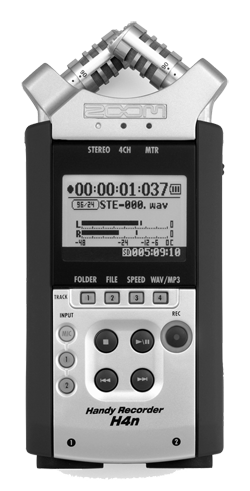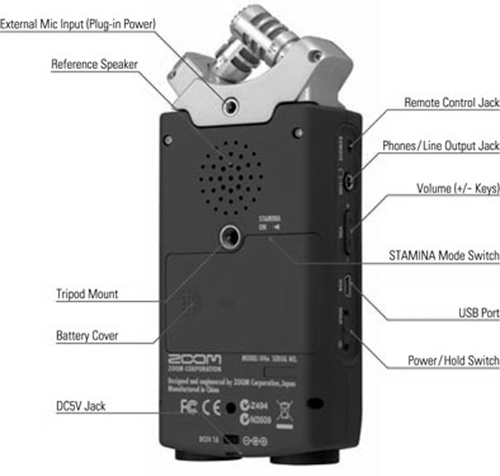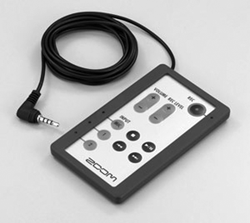by Steve Cunningham
I’ve done a great deal more location recording lately, including a number of interviews that are destined for podcasts. My go-to recorder has been the Compact-Flash-based Fostex FR-2LE (see the November 2007 issue of RAP), and it’s served me quite well connected to nothing fancier than a Heil dynamic mic. During the past Winter NAMM show, I found myself tempted by the all-in-one Flash recorders that come with built-in mics; after all, using one of those would eliminate the need for carrying a loose mic and cable along with the necessary spare batteries. One less item in the carryon bag is always a good thing.
Just prior to NAMM at the last CES show, Zoom introduced an updated version of their H4 Handy Recorder, cleverly dubbed the H4n Handy Recorder. This is not a replacement for the H4, which is still available, but rather a revised version that corrects some of the flaws in the original H4 that made it a less-than-pro product. Chief among these were the noisy external preamps, and the preamps in the H4n are noticeably quieter. And while at $350 on the street, its price slightly higher than its predecessor, the total number of features make it a good value nevertheless. Let’s look at the entire package.
 A SMALL PACKAGE
A SMALL PACKAGE
The Zoom H4n is a versatile all-in-one stereo digital recorder with combo 1/4” and XLR inputs, 48V phantom power, an onboard pair of coincident stereo mics and a lot of additional functionality, from four-track mixing to effects and a USB audio interface. In stereo mode, the Zoom H4 records 16-bit or 24-bit WAV files at 44.1 kHz, 48 kHz or 96 kHz. A full range of MP3 bitrates from 48 to 320 kbps are available for stereo recording as well, while in four-track mode the unit records at 16-bit/44.1 kHz. You can record broadcast WAVs, with markers for use when navigating or editing audio files or burning CDs. All this is, of course, recorded to SD card, and a 1GB card is included.
The H4n can take an SD or SDHC card of up to 32GB, although sadly Zoom has not yet broken the 2GB limit per audio file barrier. This puts something of a crimp in my desire to record long-form programs as linear files, since 2GB of stereo is about 3 hours. The unit will not record in a pure mono as will my Fostex FR-2LE, so I can’t use that trick either.
The H4n definitely falls into the hand-held category at roughly 2-7/8” wide, 6-1/8” deep, and 1-3/8” high and weighing in at just over half a pound (about 10 ounces). The body has a thick, rubber-like coating, which makes it less likely to slip from your clutches and take a trip to the floor. The whole device feels solid, better weighted, and altogether professional. If handling noise is an issue, there’s a camera-tripod mount on the rear, and an optional mic-stand adaptor for that. If noise is still a problem, there’s an optional remote control that plugs into the main unit via a mini-jack on the left-hand side panel that helps avoid bumps and thumps from handling when entering record mode. Unfortunately these were out of stock when my unit shipped, so I was unable to get one of these for eval.
While the 2” main screen is similar to that on the H4, the layout of the input controls is very different. Unlike the H4, the H4n has dedicated transport, input- and track-selection controls on the front panel. The four transport buttons are smack in the center of the front panel, with the Record button just to the right. To the left are three input select buttons, while four buttons just below the screen labeled Folder, File, Speed, and Format handle the setup and access chores (and yes, the H4n will playback at half-speed without changing the pitch). Three LEDs just above the screen indicate which of the three recording modes are selected -- Stereo, Four-Channel, or Multi-Track.
More on that later, but the aforementioned four buttons below the screen also double as track select buttons in Multi-Track mode. The recording level and playback volume settings are controlled by dedicated buttons on the right and left panels respectively.
At the top are the two electret condenser microphones. These are by default configured for coincident (that is, XY in the classic crossed pattern) stereo recording, but can be rotated between 90 and 120 degrees to give a wider stereo field at the expense of reduced level in the center. The mic mounting bracket features a mini-jack that let’s you connect a stereo mic, to use instead of the onboard mics. This is intended for a consumer-grade stereo mic, as the H4n provides low-voltage “plug-in power” via this jack, and you cannot use that and the built-in mics simultaneously. The aforementioned combo jacks on the bottom panel allow the connection of external mics or line level sources, and the XLR jacks can deliver 24V or 48V phantom power. The line level jacks are unbalanced. As I mentioned above, the preamps behind these combo jacks in the H4n have been upgraded from the previous version. They’re not high-quality by studio standards, but are they’re perfectly adequate for most purposes, and they lack the annoying hiss of the H4’s preamps.

A TRIPOD AND A MIXER
The rear panel is home to a small speaker. Of course the little speaker isn’t for serious monitoring, but it’s a useful addition that brings the Zoom into line with the competition. It means you don’t always need to use headphones or external speakers to ensure that things are operating as they should, or to locate a specific track or location within a track. On the other hand, I love the idea of a tripod mount, also found on the back panel. I didn’t get the mic stand adapter for it, but I did press a small camera tripod into service to good effect. Very handy indeed. Also on the back is the power connector for the included wall wart adapter, or you can pop in a pair of AA batteries.
On the right side you’ll find the SD card slot, a set of up/down buttons for setting record levels, and a paired jog dial and menu key. The latter are used together to navigate the H4n’s many screens for setup, operation, mixing of the four tracks, and the DSP effects. It’s a reasonable intuitive system that requires only the occasional trip to the manual, and then only when you want to really play with the built-in effects. The left side contains the remote control jack, the USB port for transferring sound files to your computer, and the power switch. Also on the left are the mini-jack that works for both headphones and stereo line-level output, and another pair of up/down buttons to set the playback volume.
The three modes are simpler than they appear, as the difference is that Four-Channel allows simultaneous recording from both the two built-in mics and two external mics at once, while Multi-Track allows you to monitor two recorded tracks while adding two more. In Four-Channel you’ll monitor all four inputs at once, while in Multi-Track you’ll monitor the two recorded tracks and the input of the two new tracks at the same time.
The H4n features a four-track mixer, and as mentioned, the onboard mics and external inputs can be used simultaneously for recording on all four tracks. Because the onboard mics are configured for stereo, your four-track options can seem limited, but you could bypass them using the mini-jack input and a splitter cable for a pair of battery-powered mono mics. Even without this, there are plenty of possibilities. A number of applications are suggested in the detailed manual, and there is more potential. I captured a live seminar with some 60 attendees. During setup I took a feed from the lecturn mic and connected it to the line level input, while the built-in mics were positioned to capture the audience reaction. It sounds a bit strange but it actually worked quite well, particularly during the Q&A portion of the presentation. Who knows? It might even serve as a sort of poor-man’s surround-sound recording, although that’s one option I did not explore.
Putting the H4n into four-track mode is as simple as clicking the menu button, scrolling to “Mode” and clicking, then selecting “4CH” and clicking again. A similar approach is used to set it back to stereo. The “MTR” Multi-Track mode allows you to record mono or stereo sources to each of your four tracks, apply effects to and balance those tracks, and create a stereo bounce.

USB AND FX
As a bonus, the H4n gives you what is essentially a four-in, two-out, 24-bit, 96kHz-capable audio interface. Zoom includes a copy of Steinberg’s Cubase LE4 software for Mac and PC, which I suppose would provide some entertainment during downtime between manic production sessions. In any case, it wouldn’t be my first choice as a hardware interface (the H4n is, after all, designed with location recording applications in mind) but it’s certainly usable.
Equally usable but somewhat less relevant are the built-in effects and processors. Some of these are truly essential, like the low-cut filter (selectable between 80 and 230 Hz), the compressor/limiter, and normalization, while most are aimed squarely at musicians. In fact, there are some 50 effects taken from Zoom’s various guitar pedal products that will probably provide several minutes of enjoyment before you have to get back to the grind, but even among those there are a few winners for adventurous production types. The delays and reverbs are somewhat lo-fi but still quite a lot of fun, and you can never go wrong with a good ring modulator. Never mind, you can go very wrong with a ring modulator, but there it is.
Consider these things as a big freebie in an otherwise workmanlike portable recorder. Rather than describe them, I recommend you visit their website and download the 158-page PDF manual. It will describe in great detail not only how to get a good recording with the H4n, but also how to engage the automatic wah-wah effect, if that’s what floats your boat.
 IN USE
IN USE
Compared to my FR-2LE, the Zoom H4n is a bit of a fussy beast to set up, primarily due to the screen size and the little buttons located on the sides of the unit. But for basic recording, once it’s set it works as advertised. File transfer time over USB 2.0 is about the same as for every other recorder of its type -- figure one-tenth of the total running time to transfer a file to your computer for further editing or mastering.
Battery life runs at about six hours when recording stereo (again, about the same as the Fostex). The H4n does have a STAMINA mode which allows only recording at 16/44.1, cuts the backlighting, and engages other power-saving functions that raise the battery life to nearly ten hours (there’s no equivalent on the Fostex). But the 2GB file size limit is a drag, and in some ways makes the battery life less important.
Between the two units, the preamps are close in sound. I think the Fostex is a bit more detailed on the high end and a little smoother, but the difference is very minor -- Zoom did get the previous noise problem under control. The built-in condenser mics are not flat, but still quite usable; there’s a bit of a bump in the frequency response around 3-4 kHz and a little rise around 8 kHz that plays as bright, but they’re small electrets so one expects that sort of thing.
At the end of the day, the H4n sounds good, and fits in a coat pocket. It is certainly at the top of the heap for its price (the FR-2LE I’m comparing costs a couple hundred more), and there’s good value there for the money. Steve sez check it out.
The Zoom H4n Handy Recorder carries a suggested US retail price of $609.99, although many retailers advertise it at about $350. It is in stock as of this writing. For more information in the US, visit www.samsontech.com, or worldwide visit www.zoom.co.jp.
♦

